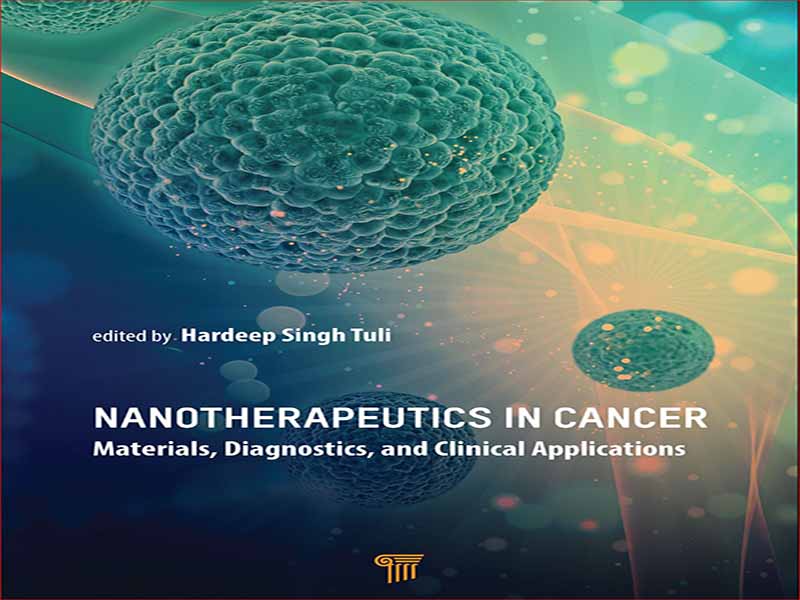- عنوان: Nanotherapeutics in Cancer Materials, Diagnostics, and Clinical Applications
- نویسنده: Hardeep-Singh-Tuli
- حوزه: کاربردهای نانو در پزشکی
- سال انتشار: 2023
- تعداد صفحه: 279
- زبان اصلی انگلیسی
- نوع فایل: pdf
- حجم فایل: 17.0 مگابایت
بروز بیماری های سرطانی در سراسر جهان به طور مداوم در حال افزایش است و سالانه باعث مرگ میلیون ها نفر می شود. از آنجایی که این یکی از علل اصلی مرگ و میر ناشی از بیماری است، تلاش دانشگاهی عظیمی با بودجه تحقیقاتی قابل توجهی به توسعه و طراحی داروهای جدید ضد سرطان و راهبردهای درمانی اختصاص داده شده است. با این حال، به نظر می رسد در نظر گرفتن علائم سرطان یک استراتژی منطقی تر برای طراحی و توسعه داروهای ضد سرطان و رویکردهای درمانی کارآمد باشد. کاربردهای دارورسانی نانوذراتی در زمینه تشخیص و درمان سرطان مورد توجه فراوانی قرار گرفته است. نانوداروها به دلیل ویژگیها و طراحی منحصربهفرد خود، پیشرفت چشمگیری در از بین بردن تومورهای وحشتناک داشتهاند. تحقیقات در نانوپزشکی سرطان تعداد زیادی از سیستمهای دارورسانی را در بر گرفته است که دارای توانایی بالا برای هدفگیری تومور، حساسیت نسبت به ریزمحیطهای تومور و کارایی بهبود یافته هستند. نانوحامل های مختلفی برای هدف گیری داروهای ضد تومور ساخته و تایید شده اند. این نانوحاملها، یعنی لیپوزومها، میسلها، نانولولهها، دندریمرها و پپتیدها، طیف گستردهای از مزیتها مانند گزینشپذیری بالا، چند کارکردی، ویژگی، زیست سازگاری و کنترل دقیق رهایش دارو را ارائه میکنند. نانودرمانها فرصتهای جدیدی را برای بهبود ایمنی و اثربخشی درمان منظم ارائه میدهند. این کتاب مروری بر ویژگیهای منحصربهفرد نانوذرات مناسب برای سیستمهای بیولوژیکی، با تاکید بر نوع نانوذرات مورد استفاده بالینی و ویژگیهای آنها برای کاربردهای درمانی، و همچنین بر استراتژیهای انتقال فعلی آنها برای بیماریهای خاص ارائه میکند. در این کتاب، نویسندگان زمینههای کنونی، از جمله طراحی نانوذرات برای درمان، انواع نانوذرات درمانی، و کاربردهای آنها در تحویل هدفمند، همراه با محدودیتها و معایب نانوذرات درمانی را مستند کردهاند.
The incidence of cancer diseases is continually increasing worldwide, causing millions of deaths each year. As it is one of the main causes of disease-related death, tremendous academic effort, with substantial research budgets, is being devoted to developing and designing new anticancer drugs and treatment strategies. However, considering the hallmarks of cancer seems to be a more rational strategy for designing and developing efficient anticancer drugs and treatment approaches. The applications of nanoparticulate drug delivery have received abundant interest in the field of cancer diagnosis and treatment. By virtue of their unique features and design, nanomedicines have made remarkable progress in eliminating dreadful tumors. Research in cancer nanomedicine has spanned multitudes of drug delivery systems that possess high tumor-targeting ability, sensitivity toward tumor microenvironments, and improved efficacy. Various nanocarriers have been developed and approved for anti-tumor drug targeting. These nanocarriers, i.e., liposomes, micelles, nanotubes, dendrimers, and peptides, offer a wide range of advantages such as high selectivity, multi-functionality, specificity, biocompatibility, and precise control of drug release. Nanotherapeutics is offering new opportunities for improving the safety and effectiveness of regular therapy. This book provides an overview on the unique features of nanoparticles that are suitable for biological systems, emphasizing on the type of clinically used nanoparticles and their specificity for therapeutic applications, as well as on their current delivery strategies for specific diseases. In this book, the authors have documented the current contexts, including designing nanoparticles for therapeutics, types of therapeutic nanoparticles, and their applications in targeted delivery, along with limitations and disadvantages of therapeutic nanoparticles.
این کتاب را میتوانید بصورت رایگان از لینک زیر دانلود نمایید.
Download: Nanotherapeutics in Cancer Materials, Diagnostics, and Clinical Applications




































نظرات کاربران